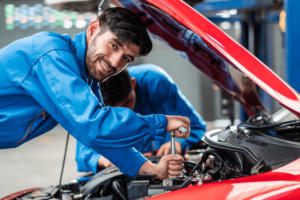As soon as you turn on your vehicle, the engine temperatures begin to rapidly rise. If it weren’t for the cooling system in your car, truck, or SUV, the motor and other internal parts could literally just melt. You don’t have to be a mechanic or car enthusiast to keep an eye on your vehicle’s cooling system. Understanding the signs of potential failure can make a huge difference. For instance, catching problems earlier can make the difference between minor repairs like a radiator hose and major repairs such as needing a new engine or vehicle all together. We are going to review signs of cooling system failure in your vehicle, so you can be on the lookout and catch any potential problems early.
What is a Vehicle’s Cooling System?
A vehicle’s cooling system consists of a number of parts, including the radiator, water pump, thermostat and hoses. Within the system, a mixture of coolant (also known as antifreeze) and water flows constantly, which is what helps to reduce the temperature inside the motor.
A vehicle’s cooling system serves not just to keep the engine cool, but to also keep its temperature warm enough to ensure efficient and clean operation. The cooling system also incorporates elements of the cabin’s ventilation system, because engine heat is used to warm the car’s interior.
The cooling system plays a vital role in the overall operating and longevity of your car, truck, or SUV.
What are Signs of Cooling System Failure in your Vehicle?
Because your vehicle’s cooling system is essential to keeping you on the road, there are some common signs of cooling system failure that you should watch for with your vehicle.
- Leaking Radiator Core: If you notice wet or dried coolant around the radiator, there could be corrosion that can eventually lead to a hole in your radiator. Coolant is generally a bright green, orange, pink, or blue-green color and very sweet smelling. Car coolant, also known as antifreeze, protects your engine from overheating. Coolant also lubricates the moving parts it comes into contact with, which protects damage to the water pump, head gasket, the cylinder and piston timing. A leaking radiator core can lead to insufficient coolant levels, which can lead to overheating, and could cause damage to your radiator.
- Broken Thermostat: When the thermostat in your vehicle starts to fail, it can stick open or closed, messing with the flow of coolant to parts of your vehicle. If not addressed, it can lead to the engine overheating. The phrase, “The thermostat was stuck open or closed”, refers to your thermostat not operating properly. When a vehicle is functioning as it should, if the engine has been sitting for a while and is not warm, the thermostat will be closed. Once the engine is running and reaches a certain operating temperature, a sensor inside the thermostat will cause it to open, allowing coolant to flow to and from the radiator, decreasing the temperature so it can be recirculated through the engine again. If you notice the temperature gauge reading very high and overheating, the temperature starts changing erratically, or you find coolant leaks, you could have a broken thermostat.
- Broken Hoses: Soft, cracked, or leaking hoses can put your vehicle at risk of major damage. The radiator hose is part of your vehicle’s cooling system. The hose carries the coolant to the radiator, where the fluid is cooled, then back to the engine to keep the vehicle from overheating. This allows your vehicle to operate at the optimal temperature and prevents the engine from getting too hot or cold. There are usually two hoses that connect to your radiator. You should watch for leaking coolant, engine overheating, low coolant, or a collapsed or broken hose. Typically, these hoses are an inexpensive fix and can keep your vehicle running at optimal operating temperatures.
- Broken Water Pump: If your water pump fails, like a thermostat, it will not properly circulate coolant through your system which can cause catastrophic engine damage. A vehicle’s water pump is a belt-driven pump that derives its power from the crankshaft of the engine. Designed as a centrifuge, the water pump draws cooled fluid from the radiator in through the pump’s center inlet. It then circulates the fluid outward into the engine and back into the car’s cooling system. There are signs to watch for that indicate you may have a problem with your water pump: coolant leak at the front-center of your vehicle, rust, deposit buildup and corrosion, whining sounds caused by loose parts, your engine is overheating, or there is steam coming from your radiator.
Does Your Phoenix Vehicle Have Cooling System Issues?
When it comes to cooling system issues, at the first sign of a problem, you should visit a local Phoenix automotive repair shop.
Advanced Transmissions & Emissions aims to make cooling system services more accessible and cheaper for our customers. Having cooling system issues is never a good thing. However, we have years of experience fixing them at cheaper rates than you will likely find elsewhere. We understand cooling systems better than most. Our expertise and diagnostic tools allow us to locate the source of the problem to make only the needed repairs. That’s how we save our customers so much money.
Sometimes, we can replace just a radiator hose or add more fluid to the coolant reservoir to fix your cooling issues. After we inspect your vehicle, we will recommend replacing worn-out or broken parts and let you know about any other issues we find. You can rely on us to recommend affordable solutions to fix your vehicle’s cooling system issues.
Visit our Phoenix, AZ shop for vehicle cooling repair.





